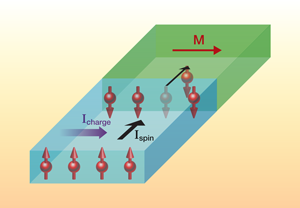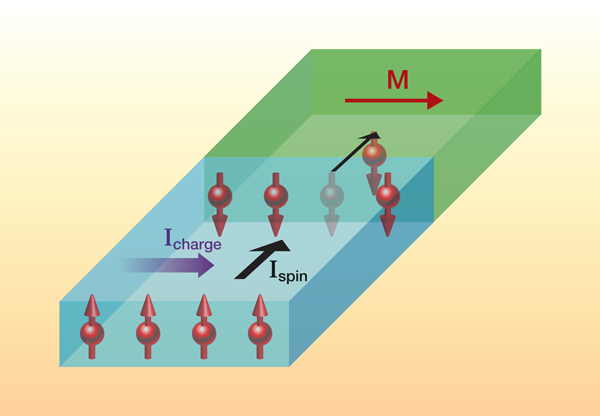Insulating Magnets Control Neighbor’s Conduction
Magnetoresistance is an important material property that is utilized in electronic compasses, hard disk drives, biosensors, and microelectromechanical systems (MEMS). In normal (nonmagnetic) conductors, magnetoresistance is a variation of the resistance that occurs when an external magnetic field influences how electrons flow through the material. In magnetic conductors, the magnetoresistance depends on the magnetization direction. In Physical Review Letters, Hiroyasu Nakayama of Tohoku University, Japan, and co-workers generate a new kind of magnetoresistance in a system with an insulating magnet [1]. The results are independently corroborated and shown to also exist in other materials by Christian Hahn of CEA Saclay (Atomic Energy Commission), France, and his collaborators writing in Physical Review B [2]. These developments may open new applications of insulator spintronics, devices that utilize spin currents in insulating magnets.
Nakayama et al. coined the term spin Hall magnetoresistance (SMR) to describe their discovered phenomenon [1]. This new magnetoresistance joins a long list of similar spin-dependent effects that have powered a wide range of applications. The first documented observation of magnetoresistance was in 1855 by William Thomson (Lord Kelvin), who reported “that the electric conductivity of iron wire is diminished by longitudinal magnetization” [3]. This is now known as anisotropic magnetoresistance (AMR) and is characterized by a directional dependence in the resistance through a ferromagnet. Many devices use AMR, such as magnetic field and electrical current sensors, but the effect is relatively small since it is caused by the weak spin-orbit interaction. A considerably larger effect with a radically different origin is giant magnetoresistance (GMR) [4]. In GMR devices, which are made of alternating layers of ferromagnetic and nonmagnetic thin films, electrons experience a different potential depending on whether their spins are aligned or antialigned with the magnetization. This spin-dependent resistance has revolutionized read heads in disk drives. A related effect, tunnel magnetoresistance (TMR), occurs in tunnel junctions between ferromagnets [5]. At present, devices using TMR have the largest magnetoresistance ratio, which is a measure of the resistance difference between parallel and antiparallel spins.
The fundamental difference of SMR as compared to these other examples of magnetoresistance is that the current need not pass through a magnet. Both Nakayama et al. and Hahn et al. create a system where a normal metal is put in contact with a magnetic insulator, in this case, yttrium iron garnet (YIG) [1,2]. Surprisingly, the resistance of the normal metal is influenced by the magnetization in the insulating magnet even though none of the charge current is able to pass through the magnet. Instead, the SMR effect is a result of spin current being able to flow from the metal into the magnetic insulator. The rate of this spin transfer depends on the magnetization direction of the insulator. The more spin current passing across the metal-insulator interface, the weaker the charge current flowing through the metal. The end result is a slight increase in the effective resistance. The authors provide a detailed explanation of this phenomenon based on two main ingredients: the spin Hall effect and spin-dependent scattering at normal metal-magnetic insulator interfaces.
The first ingredient, the spin Hall effect, is a spin-dependent analog of the Hall effect. The more familiar Hall effect occurs when a magnetic field is applied perpendicular to current flowing in a wire. The induced Lorentz force causes charge carriers to move transversely in the wire, resulting in a collection of positive/negative charges on opposite edges of the wire. This charge imbalance creates a transverse voltage. In the spin Hall effect, the current in a wire is influenced not by a magnetic field, but by the spin-orbit coupling that drives a perpendicular spin flow. Consequently, spins of opposite sign collect on the edges, leading to a spin polarization that is perpendicular to both the current and the induced spin flow (see Fig. 1). The reciprocal phenomenon also exists: the inverse spin Hall effect, where a longitudinal spin current induces a transverse charge flow.
The second ingredient for SMR is spin-dependent scattering at the metal-magnetic insulator interface. This scattering, which causes spin transfer and spin relaxation in magnetic insulators, depends on the orientation of the spin current polarization with respect to the magnet’s magnetization. When the polarization of the spin current is aligned with the magnetization, the spin current cannot penetrate into the insulator—as if it were a normal insulator or vacuum. In contrast, when the edge spin accumulation is perpendicular to the magnetization, spins can pass into the insulating magnetic layer through spin-transfer torques [6]. These torques induce excitations in the magnet and cause a loss of angular momentum (or spin relaxation) in the metal.
Both experimental teams found that they could control the resistance in the metal by orientating the magnetization of the magnetic insulator. This control is derived from the influence that the edge spin accumulation has on the longitudinal charge current via the inverse spin Hall effect. When spins transfer through the metal-insulator interface, the net effect is a reduced edge spin accumulation that brings down the longitudinal charge current. In other words, the resistance in the metal is higher when the magnetization in the insulating magnet is perpendicular to the spin accumulation.
To verify the above interpretation, Nakayama et al. carried out measurements with copper and silicon dioxide inserted between the insulating magnet and normal metal (platinum in their experiments). These extra layers blocked the spin transfer and, in so doing, turned off the resistance control, thus demonstrating that the observed SMR behavior is not due to some AMR-related effect. Hahn et al., for their part, checked how generic the effect is by substituting platinum with tantalum, a normal metal with an opposite-sign spin Hall angle (meaning the edge spin polarization is reversed). They also carried out additional ferromagnetic resonance (FMR) linewidth measurements and investigated the effects of metal thickness.
The measured SMR effect is a change of roughly in the resistance through the metal, which is much smaller than typical values of AMR, GMR, and TMR. Still, it is possible to localize SMR because of its unique angular dependence on the relative orientation of the current, magnetization, and film orientation. And despite its small size, SMR could prove valuable because it enables direct electrical sensing of the magnetization in insulating magnets. This is essential in the rapidly developing field of insulator spintronics, where electrical sensing can be used to determine the magnetic structure of insulating magnets, as well as answer questions about spin transfer and spin-pumping (the emission of spin currents by a dynamical magnetization) inside these materials. However, a full understanding of the spin dynamics in normal metal-insulator magnet systems may require further studies that can narrow down the parameters that go into the current models. Indeed, during the writing of this Viewpoint, additional results were announced that prove that SMR also exists in the magnetic insulators nickel ferrite and magnetite [7]. Other groups are also exploring SMR and how it depends on the direction of the field and the thickness of the metal layer [8]. Future surprises may await as other combinations of magnetic insulators and normal metals are tried together.
Note added (14 May 2013): The original article omitted a reference to a related paper (Ref. [8]). The reference and a brief explanation of its relevance have been added.
References
- H. Nakayama et al., “Spin Hall Magnetoresistance Induced by a Nonequilibrium Proximity Effect,” Phys. Rev. Lett. 110, 206601 (2013)
- C. Hahn, G. de Loubens, O. Klein, M. Viret, V. V. Naletov, and J. Ben Youssef, “Comparative measurements of inverse spin Hall effects and magnetoresistance in YIG/Pt and YIG/Ta,” Phys. Rev. B 87, 174417 (2013)
- W. Thomson, “Bakerian Lecture: On the Electro-Dynamic Qualities of Metals,” Philos. Trans. R. Soc. London 146, 649 (1856), section 146 of Part 4, and Part 5; http://www.jstor.org/stable/41206195
- M. N. Baibich, J. M. Broto, A. Fert, F. Nguyen van Dau, F. Petroff, P. Etienne, G. Creuzet, A. Friederich, and J. Chazelas, “Giant Magnetoresistance of (001)Fe/(001)Cr Magnetic Superlattices,” Phys. Rev. Lett. 61, 2472 (1988); G. Binash, P. Grunber, F. Saurenbach, and W. Zinn, “Enhanced Magnetoresistance in Layered Magnetic Structures with Antiferromagnetic Interlayer Exchange,” Phys. Rev. B 39, 4828 (1988)
- M. Julliere, “Tunneling Between Ferromagnetic Films,” Phys. Lett. 54A, 225 (1975)
- A. Brataas, A. D. Kent, and H. Ohno, “Current-Induced Torques in Magnetic Materials,” Nature Mat. 11, 372 (2012)
- M. Althammer et al., “Quantitative Study of the Spin Hall Magnetoresistance in Ferromagnetic Insulator/Normal Metal Hybrids,”arXiv:1304.6151
- N. Vlietstra et al., “Spin-Hall Magnetoresistance in Platinum on Yttrium Iron Garnet: Dependence on Platinum Thickness and In-plane/Out-of-plane Magnetization,” arXiv:1301.3266v2





